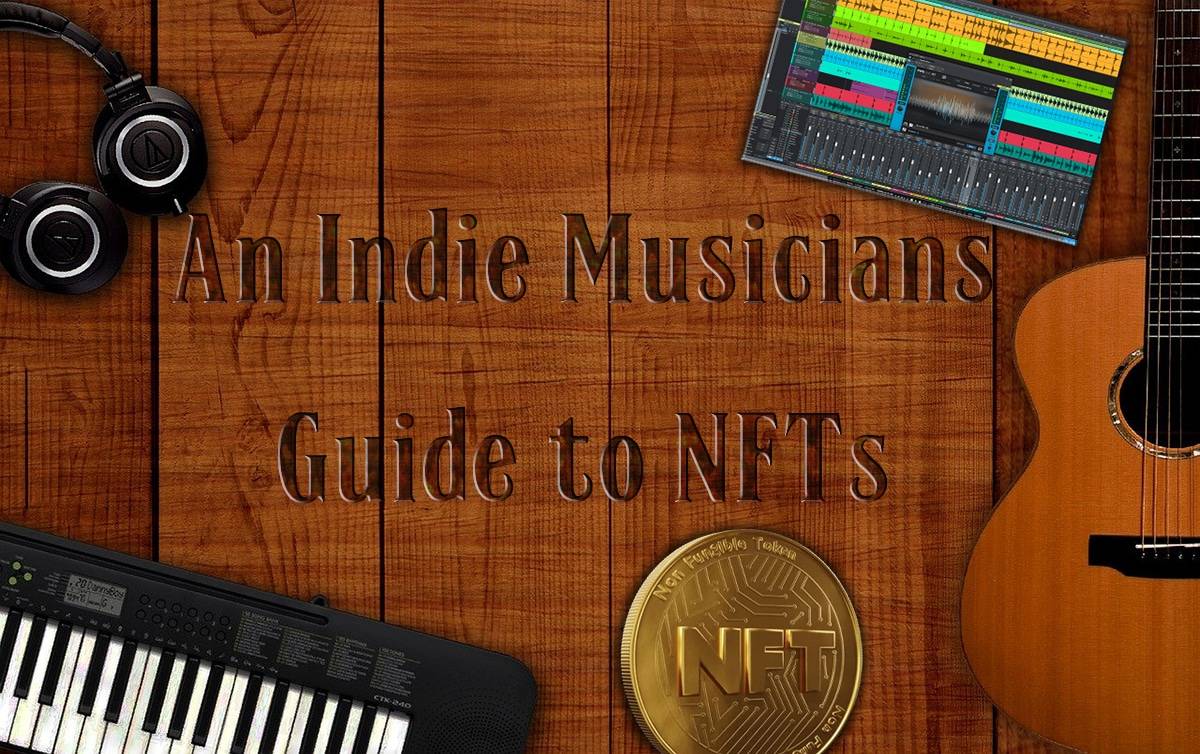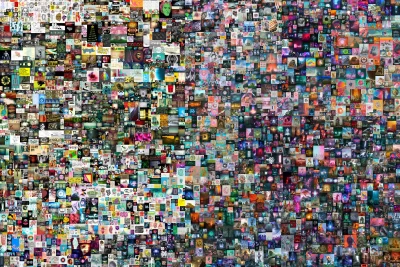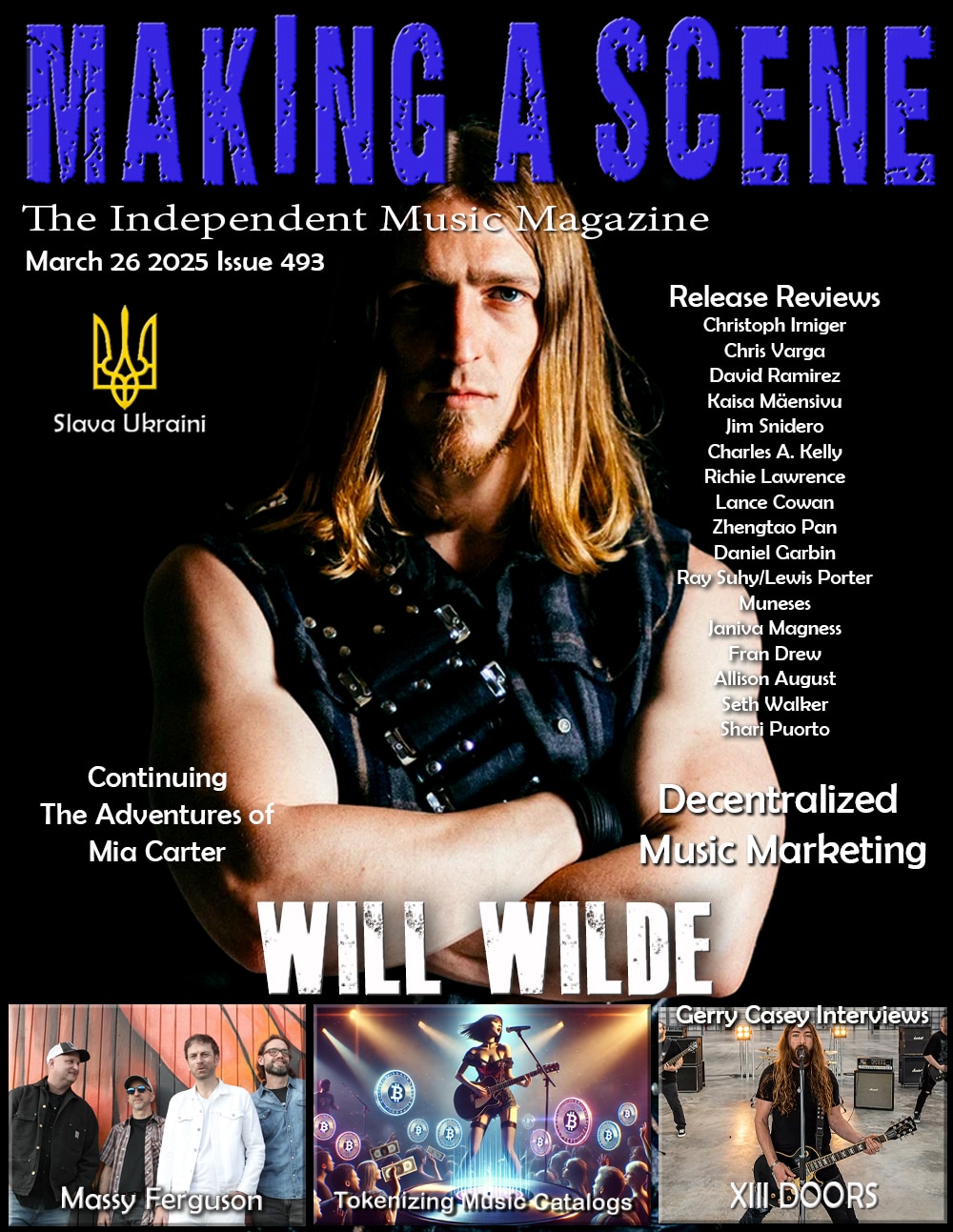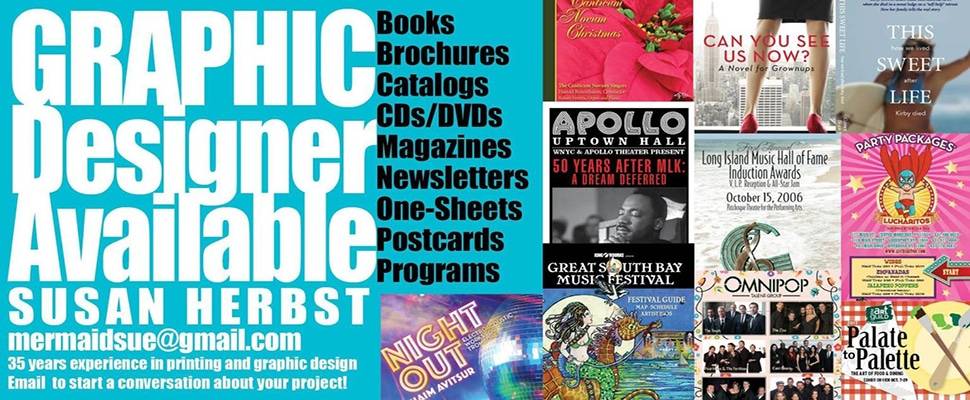An Indie Artist Guide to NFTs

Making a Scene Brings you the Indie Musicians Guide to NFTs
The newest buzz in the music industry is the NFT (Non Fungible Token), which many are touting as a way for indie artists to take control of their monetization through the crypto currency market. I will be honest on the onset the idea of buying and selling digital collectables was not something I was initially able to wrap my head around. I started to do some research so I can fully understand what NFT’s are and how they can be used to create revenue streams for the Indie Artist.
Why Should you Care?

Whenever I look at anything new in the music industry the first thing I take a look at is it’s economic viability. Is there money being made? Are large corporations taking these transactions seriously? From what I have seen the answer is definately yes.
The first example is auction house Christies one of the most prestigious fine art auction houses in the world. They typically deal in multi Million dollar Art, antiques, Collectables and of course memorabilia. They have recently began holding NFT auctions one of which the art from digital artist “Beeple” sold for over $69 million dollars. Now remember this is not a physical work of art! This is for a digital piece of art an NFT that contains the image noted in this article, but the owner now has the exclusive ownership of this art as well as the certificate of authenticity. Couple this with the fact that Prior to this the artist Beeple typically sold his work for $100 or less. Now he is one of the top 5 most valuable living artists in the world! This makes me want to pay attention!
Cryptopunks and CryptoKitties were at the beginning of the NFT craze and believe it or not, these 8 bit digital art NFTs are selling for hundreds of thousdands of dollars. The CryptoPunk #4731 Sold for $319,083.03 while CrytoPunk 3831 Sold for $2.08 Million Dollars and as of Sept 2021 it has an offer to purchase it for over $20 Million Dollars! CryptoKitties on the  other hand are digital cats that you can buy, sell and believe it or not, breed. CryptoKitty: Dragon Sold for $1,344,555 with many of the cryptokitties fetching hundreds of thousands of dollars!
other hand are digital cats that you can buy, sell and believe it or not, breed. CryptoKitty: Dragon Sold for $1,344,555 with many of the cryptokitties fetching hundreds of thousands of dollars!
Now if I had a couple million dollars I don’t believe I will be buying 8bit digital art anytime soon or get into breeding digital cats, but the reality is there is a market here and that market is worth billions of dollars. In fact in the first half of 2021 NFTs have exceeded $2.5 Billion in sales, something that we cannon ignore no matter how much of what is being sold makes little sense to us as to it’s value.
Now, If the world of NFTs were nothing more than the very rich buying and selling virtual kittens and cats, I would not give it another thought. But, the fact remains that there is a multi billion dollar mainstream market here and that alone dictate that we cannot ignore it!
Even the NBA has jumped on the NFTs popularity with their Top Shop series and Highlight Reels. Recently the Lebron James Highlight NFT Sold for $208,000 and It’s the first time that specific highlight, which features James slamming over Nemanja Bjelica in November 2019, has been sold. There were 49 of those highlights minted, labeled by Top Shot as “Cosmic” and was originally plucked out of a pack for that originally sold for $230. Before the Lebron sale, there had been roughly a dozen sales on the Top Shot marketplace in the $100,000 range.
As the market grows, many in the music industry are experimenting with NFTs to see what is viable and works in the market. Some artists are selling a percentage of their publishing rights to songs in NFT’s something that is not unusual for the music industry as many record contracts stipulate a percentage of (if not all) of an artists publishing be assigned to the record company. By selling part of the publishing of a song to your fans, they give their fanbase a way to directly invest in the artist and their work and to benefit from their success.
Musicians are also realizing that the NFT can be used to sell a part of their brand or to give the fans a unique access. An extreme example of this is when Rapper Azealia Banks sold an audio sex tape of her as an NFT for more than $17,000 that also included the right to resell it. As you can see the limits are endless!
Think about it, because of self executing smart contracts and defined ownership, the need for PROs, Sound Exchange and any other middle man organizations between the artist and their revenue stream becomes unnecessary! This could revolutionize the whole music industry by giving the artist complete control over their revenue without any middle corporate entities cutting into the pie. You could in effect create a public funded NFT record company that your fans would be able to purchase NFT shares in and in return a smart contract can give each owner of the NFT a share in the revenue stream of that project, like a traditional record contract but with terms defined by the artist. You could also define a percentage of royalty that will go back to you each time a user resells that NFT record company share.
There are now moves being made that would redefine the world of streaming. Imagine a platform that gives the public access to all the music they love like Spotify does now but would use NFT smart contracts to track and pay artists directly removing the large corporate companies like Spotify, Apple Music, etc. Giving indie musicians control over their music, and the funds that it generates.
What is an NFT (Non Fungible Token)
Let’s start with some definitions of the terms used in this new technology
Fungible – The best way to look at Fungible object is Money. If I had a $10 Bill and asked you for change, you could give me two $5’s or a $5 and five $1’s or even ten $1 bills. The Bottom line no matter how I give you change, it is exactly the same in worth as the original $10 bill. No matter what configuration that $10 is, it’s still $10. This is what makes Money “Fungible”. One Dollar is exactly the same as the Next Dollar and they are interchangeable. Because of this relationship and interchangeability it is defined as fungible.
Non-Fungible – As the name implies, Non-Fungible is an object that has no equivalent value and cannot be exchanged for something that would be equal to it’s value. Such as a work of art. If I had an original Picasso painting, it is a one of a kind, unique item. I can put a value on it, but once I have sold it I no longer have that item or it’s equivalent. The money is only what is used to exchange that unique item from one person to another, and that value can fluctuate over time. But, that work of art will always exist as a unique whole item. Let’s take the example of a concert ticket, as a rule they are each unique or non fungible because each ticket defines a specific date, time and seat number. No two tickets are exactly the same and are not really interchangeable because of their uniqueness.
Block Chain – The block chain is a decentralized and transparent digital ledger that contains the certificate of authenticity, Ownership and any underlying contracts for NFTs. The unique thing about the block chain is data can be added to the block chain or modified, but it cannot be deleted from the block chain. The block chain is also transparent in that anyone can see what is in the chain, but you must have the “key” or ownership of the NFT to access the data. A blockchain is essentially a digital ledger of transactions that is duplicated and distributed across the entire network of computer systems on the blockchain. Blockchains are recorded with a cryptographic signature called a hash. There are several Block Chains that allow for NFT creation, the largest is Etherium.
Gas Fees – NFT Gas is the term given to the fee that most NFT trading platforms charge. This is incurred to conduct the transaction or execute a contract on their blockchain platform. Gas prices in Ethereum are denoted by a unit of Gwei. It is determined by the amount of traffic on the network and the computation power taken to execute a transaction. The Amount of Gas required to “mint” an NFT can fluxuate with the market price of ether, and the amount of traffic on the network needed to compute and verify the NFT onto the block chain. If you are going to mint your NFTs on the Ethereum blockchain, you are best to keep an eye on the gas fees and pick a time when they are at their lowest. These fees can range from $50 to $350 depending on the traffic. There are options now that allow you to avoid these gas fees such as minting your NFTs on the Polygon Blockchain.
Ethereum – Ethereum is a block chain technology that lets you send cryptocurrency to anyone for a small fee. The Ethereum currency is called “Ether” and it trades on the crypto currency market like Bitcoin. It also powers applications that everyone can use and no one can take down. It’s the world’s first programmable blockchain. Ethereum builds on Bitcoin’s innovation, with some big differences. Both let you use digital money without payment providers or banks. But Ethereum is programmable, so you can also use it for lots of different digital assets – even Bitcoin! This also means Ethereum is for more than payments. It’s a marketplace of financial services, games and apps that can’t steal your data or censor you. As of this writing either is going for a little over $4,000 a coin, but you don’t have to buy a whole coin, the market is based on fractions of a coin.
Polygon – a protocol and a framework for building and connecting Ethereum-compatible blockchain networks that offers one-click deployment of preset blockchain networks, Growing set of modules for developing custom networks, Interoperability protocol for exchanging arbitrary messages with Ethereum and other blockchain networks, Modular and optional “security as a service” and Adaptor modules for enabling interoperability for existing blockchain networks. More importantly on Opensea.io you can mint your NFTs on the Polygon blockchain for free because they require much less computing power to create. The currency for the Polygon block chain is MATIC and it trades on the crypto currency market. As of this writing a MATIC coin is going for a little over $1.90 a coin.
Smart Contract – A smart contract is a self-executing contract with the terms of the agreement between buyer and seller being directly written into lines of code. The code and the agreements contained therein exist across a distributed, decentralized blockchain network. For example you can put in the smart contract that you get a percentage of all future sales of your NFT basically forever. This “Royalty” is automatic whenever a user resells your NFT and the monies get deposited directly into your digital wallet immediately. You can also include exclusive data or links that are only available to the person that owns the NFT. Such as videos, Links to external data, show tickets, etc. The beauty of the Smart Contract is there is no limit as to what is contained within it as it is an executable program and could in effect redefine the music industry by creating a direct connection between the artist and consumer with no middle man.
Crypto Wallet – This is a digital application or hardware device that allows you to safely and securely store your crypto currency. A cryptocurrency wallet is an app that allows cryptocurrency users to store and retrieve their digital assets. … When a user acquires cryptocurrency, such as bitcoins, they can store it in a cryptocurrency wallet and from there use it to make transactions.
Data Mining – Bitcoin mining is the process of adding transaction records to Bitcoin’s public ledger of past transactions or blockchain. This ledger of past transactions is called the block chain as it is a chain of blocks. The block chain serves to confirm transactions to the rest of the network as having taken place. Bitcoin nodes use the block chain to distinguish legitimate Bitcoin transactions from attempts to re-spend coins that have already been spent elsewhere.
NFT-So based on the above terms, An NFT is a token that asserts authenticity and ownership of either a digital or physical asset (yes you can include real world assets in your Smart Contract) and contains a contract between the seller and the buyer which can assert terms, rights and usage of the contained assets. This information is stored on the Block Chain for all to see, but it’s ownership and authenticity belongs exclusively to the owner. As an Example, Joe Bonamassa actually created an NFT auction that included an original song he recorded as well as the winner of the NFT auction will also get a 1959 Les Paul Sunburst and a 1963 Vibrolux Fender Amp directly from Joe’s collection!
How to Create your own NFTs
I suggest you do your research on NFTs before you dive in, but I do want to give you a step by step guide on how to create your own NFTs and best yet, do it for free!
As a Disclaimer this is not advise or any recommendation to invest in crypto currency, but instead a guide to what is entailed in creating and getting into the world of NFTs. I am not a financial advisor or an expert in investment in crypto currency and any opinion is based on my personal experience.
- Purchase some Ether on Coinbase – Your first step is to get into the world of crypto currency. One of the best and most secure marketplaces to purchase and trade crypto currency is Coinbase! Coinbase will allow you to purchase Bitcoin and Ether. Ether is an important currency as it is designed specifically for the creation and storage of smart contracts that are essential to NFTs. If you purchase $100 of currency they will give you an additional $10 plus you will have the opportunity to make another $26 by watching a few videos on Crypto Currency. This is $36 right off the bat you get for free on top of your $100 investment. Coinbase tracks the crypto market and continually updates your investment as the market moves. You can also move between Bitcoin, Either and other Alt Coins
- Get a Metamask Wallet – Metamask is a free chrome extension and mobile app that allows you to connect to the various NFT marketplaces. It is in these marketplaces you will create your NFTs and place them for sale. Metamask is free and fairly simple to setup and get running.
- Sign up with a Marketplace – There are several major NFT marketplaces out there. One of the largest marketplaces to sell and purchase NFTs is Opensea.io. You should make it a point to sign up with Opensea.io and connect your Metamask wallet to it. Some of the other marketplaces are Rarible.com , SuperRare, Foundation, and Nifty to name just a few of the more popular ones. But, Opensea is the largest and has the most users then any of the others as of this writing.
- Make Your NFT – Once you have decided on what you are going to include in your NFT Hit create in Opensea, and follow the instructions. From here you can add a commission on any future sales that will come back to you as well as what assets you want to upload as part of the NFT. You can also include offline assets that are locked and are only available to the person that purchases your NFT. Also it’s here that you decide to create the NFT on the Ethereum blockchain or you decide to create it on the Polygon Blockchain. As of Now The Polygon blockchain is FREE to mint and sell NFTs where Ethereum can cost anywhere from $50 to $350 in Gas Fees. I created a series of NFT’s, on the Polygon blockchain, of issues of an entertainment newspaper I was the publisher of in the early 2000’s (Long Island Entertainment). The purchaser of the NFT will get a link where they can download the PDF of the complete issue as it was originally printed and published.
- Creating More than one – initially on Opensea you can only create a single NFT edition per upload. This doesn’t work well for selling music or shares in publishing, digital merch, etc. Fortunately I have found a work around that works great with Opensea. When you click on create go to the URL in the address bar and add “?edition_supply=true” to that URL stream and hit return. Once you do this you can create as many editions of your NFT you want.
- Selling your NFT – if you created your NFT on the Polygon Blockchain all you need to do is click the sell button in your NFT and sign for it in your Metamask wallet and your NFT is now available for purchase on the Opensea Marketplace. If you created your NFT on the Ethereum blockchain, you will need to pay the gas fee from your wallet (which would require you to move ether to your wallet from your exchange) and again sign for it in your wallet.
Conclusion
Through this journey I tapped into the Udemy courses to gain an understanding of exactly what this technology is and how it is applied. The great thing about Udemy is many of their courses go on sale for $9.99 periodically and I was able to pickup a few courses to help me. This is how I met Clarian North a musician and instructor on Udemy and the first indie artist to put a full Release up as an NFT (See our interview with Clarian North). I strongly suggest you check out these courses and get yourself fluent in the language of this new technology.
The More I investigated the world of NFTs and Blockchain technology as they apply the the music industry the more I became convinced that we are on the doorstep to the next revolution in the music industry. The deeper I got into what can be done with this technology the more I wanted to know and to be quite honest, the more I knew I needed to know about how this all works.
As more major artists jump on board this new technology the more fans will become acclimated to the world of NFTs and using crypto currency to purchase them. The fact that this technology is in it’s infancy, and the unlimited potential of how smart contracts and applications can be imbedded into the blockchain wrapped into these NFTs it became clear quickly the sky is the limit as to what and how it can change the music industry.
Let’s face it, Streaming, as much as we have a love hate relationship with it, has changed not only the music industry but also has changed the perception of recorded music in the mind of the consumer from a product to a service. This shift in perception has hit the revenue stream of almost all indie artists and it will continue as the hardware to play CD’s continue to leave the marketplace (try buying a new car with a CD player in it). The onset of blockchain technology and NFTs holds a promise of a future where the artist and the fans will be able to have a direct connection, both financially and metaphysically. Artist will be able to make fan experiences available directly to their fanbase in a controlled and secure environment. You can offer your fans, zoom lessons on your instrument, Backstage access, VIP Tickets, Exclusive content, etc. There is no limit as to what you can do with this technology.
The world is getting ready for Web 3 where the internet will not be a place where you go on, it will be where you go into. Facebook has changed their name to Meta in anticipation of this new wave of technology. The Blockchain and NFT’s will become the marketplace and financial foundation for this new world and you as an indie artist will not want to be caught in a position where you are unable to take advantage from the beginning. Take some time to learn and understand this new technology, your place in the future of the music industry will depend on it.
Below I have listed some companies that are using the blockchain technology and NFTs to change the industry. This is happening now!
Companies currently using Blockchain Technology for Music Industry
Vest-Vezt is the first mobile app where music fans can share royalty rights for songs and recordings by artists they love. We exist to improve the music industry by providing artists, songwriters, and producers with funding sourced directly from their fans on a global basis. In exchange, fans get the right to receive royalties earned by their favorite songs and recordings. Vezt collects these royalties on behalf of fans from performing rights organizations, publishers and record labels and tracks such royalties through proprietary blockchain technology.
Mediachain – Mediachain is a peer-to-peer, decentralized database for sharing information across applications and organizations. Using content addressing, data is tamper-proof and decentralized, enabling location-independent collaboration with no central point of control.
OpenMusic Inititive – Open Music is a non-profit initiative of the Berklee Institute for Creative Entrepreneurship (BerkleeICE), part of the Berklee College of Music, as well as a number of leading academic institutions, music and media industry organizations, creators, technologists, entrepreneurs, and policy experts who love and value music. The aim is to create an open protocol for uniform identification of music creators and rights holders across the industry. Open Music believes new technologies can be applied to radically simplify the way Music Creators, performers and music rights owners are identified.
OPUS – OPUS seeks to take on the issue of unfair royalty distribution in music streaming head on, operating a decentralized music hosting, discovery and listening platform that allows users to support artists more directly. The platform is based on the Ethereum blockchain with tracks stored on the Interplanetary File System (IFPS) to drastically reduce server costs.
Musicoin Foundation – The company’s blockchain platform allows for the transparent and secure peer-to-peer transfer of music. Their coin, MUSIC, is a global currency that supports all trade surrounding music and music-related purchases. Musicoin eliminates the need for third-parties, which means that 100% of all streaming revenue goes to the artist. 95% of internet users don’t have access to music online, unless they subscribe to an expensive and closed streaming service. With the power of $MUSIC blockchain, they can now stream independent music for free, from a constantly growing catalog of labels and artists. There’s no ads, it is free, easy to share, and artists get paid instantly.
Viberate – Viberate is the all-in-one platform for growing your music career. Joining over a million up-to-date pages of Artists, Venues, Events & Festivals, the platform allows music industry professionals to track performance, showcase their work, and explore vast new business opportunities. Want to know which artist, event or venue is trending? Check out Viberate’s curated profiles that highlight an artist’s upcoming shows, social media engagement and music videos. Viberate uses blockchain to manage millions of crowdsourced data points, with real-time rankings and profiles. It rewards community participants with VIB tokens, which the company views as a go-to digital currency in the music industry.
Bitsong – The first Music NFTs Marketplace! BitSong is a distributed (open source) blockchain music ecosystem born in December 2017, to create a decentralized and trustless hub that interconnects the various market players. BitSong’s mission is to decentralize the music industry by simplifying the bureaucracy as much as possible in order to offer artists a meritocratic, transparent, fast and intermediary-free earning model and users a new way to listen to music and be rewarded.
Blockpool – In addition to its work in other industries, Blockpool creates digital tokens, formulates smart music contracts and tracks licensing and intellectual property rights for the music industry. The company helps musicians implement blockchain throughout the whole production, distribution and management process. Record label, One Little Indian, partnered with Blockpool to release European musician Bjork’s Utopia album. Blockpool implemented blockchain to provide digital currency incentives and to manage and distribute royalties.
Audius – Audius is basically a blockchain alternative to Spotify or SoundCloud. After artists upload their content onto the company’s platform, it will then generate timestamped records to ensure that all work is correctly recorded. Audius eliminates the need for third-party platforms by connecting artists directly with consumers. Additionally, Audius uses blockchain to ensure that artists get paid fairly and immediately via smart contracts. Currently in late development stage, Audius just received $5.5 million in funding to further their streaming service. The company is advised by wide range of big names in the music and tech industry, including 3Lau and executives from Robinhood, Pandora and Twitch.
OnChain Music – OnChain Music exists to help its roster of artists, bands, singer-songwriters, DJs and musicians of all kinds earn more money from their royalties through blockchain and the sale of NFTs. The platform has created the $MUSIC token, a hybrid cryptocurrency that combines characteristics of a utility, governance and revenue share token. As the value of the $MUSIC token increases, artists signed to OnChain’s roster have the potential to receive increased royalty payments — turning their music into a valuable investment. The $MUSIC token is currently available for trading on Uniswap and PancakeSwap, and OnChain’s roster currently features 235 artists, 10 record labels, nearly 2,000 songs and over 300 albums.
Blokur – Blokur helps musicians and music companies get paid what they should, when they should, by ensuring that their rights are accurately represented. 70% of the music publishing sector uses Blokur to manage their rights more effectively. Blokur is an official partner of the Mechanical Licensing Collective’s Data Quality Initiative.
Emusic – Founded in 1998 with the goal of being the #1 music service and brand for independent-minded fans, eMusic has served a community of 50 million users with personal music journeys leading to a deeper connection to music and artists. As the industry has shifted and evolved, we’ve had a front row seat to changes in the industry that have hijacked value and revenue from the artists and placed many music services in jeopardy. The eMusic Blockchain project is a unique opportunity to help solve these supply-side issues that are restricting the earning potential for artists. EMusic’s decentralized music platform features instant royalty payouts, a rights management and tracking database, fan-to-artist crowdfunding and back-catalog monetization for copyright holders. EMusic also rewards fans by offering exclusive artist content, promotional incentives and cheaper prices relative to other streaming sites.
Check out these Udemy Courses By Clarian North
 |
 |
Buy Us a Cup of Coffee!
Join the movement in supporting Making a Scene, the premier independent resource for both emerging musicians and the dedicated fans who champion them.
We showcase this vibrant community that celebrates the raw talent and creative spirit driving the music industry forward. From insightful articles and in-depth interviews to exclusive content and insider tips, Making a Scene empowers artists to thrive and fans to discover their next favorite sound.
Together, let’s amplify the voices of independent musicians and forge unforgettable connections through the power of music
Make a one-time donation
Make a monthly donation
Make a yearly donation
Buy us a cup of Coffee!
Or enter a custom amount
Your contribution is appreciated.
Your contribution is appreciated.
Your contribution is appreciated.
DonateDonate monthlyDonate yearlyYou can donate directly through Paypal!
Subscribe to Our Newsletter
Discover more from Making A Scene!
Subscribe to get the latest posts sent to your email.














































